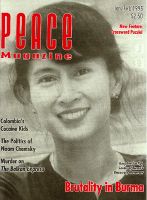
Peace Magazine Jan-Feb 1995, page 29. Some rights reserved.
Search for other articles by John Marshall here
Kay Macpherson. U of Toronto Press 1994
Kay Macpherson's remarkable life story brims with details of persons and places. It is a vivid and lively journey. Kay comes through as a relentless force of nature, making friends and developing contracts. She is an inspiration and a role model for hundreds of people (mostly women) whom she describes with loving candor. She is sometimes critical, but far more often expresses unabashed admiration. More than anything, we learn about Kay Macpherson through the quality of her friends and colleagues, comrades and sisters in her struggle.
Of her abundant personal qualities, one which shines through all the trials and triumphs and occasional failures is her zest for life and raw experience. Thus it comes somewhat as a surprise to discover her youthful bashfulness, and her early difficulty seeing herself in a leadership role. In later life, with hardwon insight into her own limitations, she is able to share with the reader her excruciating pain when she realizes the inadequacies, failures even, of her familial role. Yet woven through the book also is the moving, long-sustained love story of Kay and Brough Macpherson, a marriage that was truly mutual, supportive, and comradely.
Kay grew up in England and became a physiotherapist. She moved first to Montreal and then to New Brunswick, where she met Brough. She was already a leader in her profession, demonstrating her remarkable talents for organization. Along with marriage and three children, and settling in Toronto (Brough at U. of T.), there were trips throughout Canada and to England, making lifelong friends along the way.
Then begins the story of Kay's volunteer involvements, first with the Association of Women Electors (AWE), of which she soon was president (1957-58). This was her apprenticeship in political activism at the grassroots (or kitchen table) level. "Thus one prepares," she writes, "...for the making of speeches, the chairing of meetings, the lobbying and political negotiating that is part of being in the women's movement, the peace movement, and all those other busybody actions that...must be undertaken." None of this was easy; she recalls many "nerve-racking moments" which she learned to manage with apparent aplomb.
As AWE faded, Kay was drawn into the more politically committed Voice of Women (VOW), and thus into the women's movement. Kay was president of VOW from 1963-1967. The chapters on VOW show a mature Kay Macpherson in full flight as organizer supreme, able to harness the abilities of many diverse women, building consensus in pursuing the major issues from the '60s through to the '90s. VOW developed exceptional militancy and imagination in dealing with the powers-that-be, and pioneered linking up with women's organizations world-wide in concerted attack on issues of common concern. "As president of VOW," Kay writes, "I became a travel agent, tour organizer, conference manager, press agent, and would-be diplomat. All this was priceless experience, filled with crises, emergencies, hilarious situations, some very worrying moments, and some very moving ones."
From VOW Kay proceeded naturally into the National Action Committee on the Status of Women (NAC) of which she was president 1977-79. NAC has long been recognized as the major lobby group for women, indeed for families, in Canada. From negotiating crucial constitutional amendments to mounting campaigns for universal daycare, NAC has been the leading and most effective voice.
During this same period, Kay was a founder of Women for Political Action (1972-82). WPA was undertaken to encourage the participation in politics of women with an explicitly feminist agenda, not dependent on the essentially patriarchal parties we now have. However, the educational and consciousness-raising activities of WPA did not preclude members running for office under existing party banners, in Kay's case for the federal NDP in 1974, 1979, and 1980. She did not win, but she effectively dealt with the issues and was a memorable campaigner for the feminist cause.
From the '80s into the '90s, Kay was active in the larger peace movement which campaigned against the Cold War and the stupidities of both sides.
The book shows one woman's ability to effect change at many levels of her and others lives. It also celebrates the huge potential of women, collectively, to change the world, to really transform power structures and relationships in a lasting way.
Kay Macpherson is a true subversive. Nothing male, patriarchal, or just plain stupid is safe from her withering exposure. When she was presented with the Order of Canada and the Governor General asked, "And what have you been up to lately?" She replied, "Revolution." Such subversion is essential to the health of the body politic.
Yea Macpherson!

Peace Magazine Jan-Feb 1995, page 29. Some rights reserved.
Search for other articles by John Marshall here